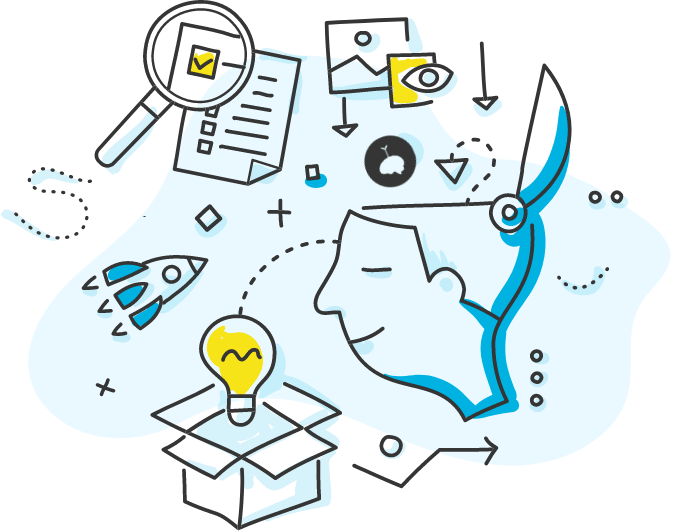
Before radio, TV, and the internet came along, you probably subscribed to a newspaper to learn what was happening outside the boundaries of your life. No newspaper subscription? That was fine. Actually, life was probably simpler, calmer, and more enjoyable. Maybe you woke up, hit snooze on your alarm a couple of times, wiped the sleep from your eyes, said good morning to your family, made breakfast, traveled to work, came home, and enjoyed your evening—all with no interrupting rectangles in sight. You could switch between tasks with greater ease and a calm mind, and it’s possible that a certain peaceful productivity wound its way through your days. You had the energy to get stuff done. Life was obviously not without stress—but there were fewer things to worry about and you paid less mind to events that didn’t directly influence your life.
As time marches on, our “surface area of concern” has expanded. This is what I call the scope of the events and concerns we pay attention to on a regular basis.
Over time, this surface area of concern has been influenced by technological progression. Long after the newspaper came along, radio became the mainstream way to turn the dial and engage our mind. After radio came broadcast television—oh, sweet wonderful broadcast television!—which introduced the nightly news and paved the way for 24-hour cable news channels.
These new mediums were entertaining and informative. And, crucial to this article, they allowed us in any moment to discover events happening outside our life. Most stories didn’t directly affect us, but that didn’t matter: the news let us hold the whole world in our hand and understand how we fit into the bigger picture. We also learned about the lives of other people, and what they were going through.
You already know what happens next: after the advent of radio and TV came the internet, which expanded our surface area of concern yet again. It’s easier than ever to consume news online, and more interestingly, it’s far more immediate. We’re no longer beholden to the predefined, scripted pace of radio and TV news—we can skim countless stories at once and soak in knowledge as if there’s no tomorrow. Through darting eyes and fragmented attention, we take in the world.
Our surface area of concern has grown with each new medium. This is not inherently good or bad, but there are a few factors that make our ballooning area of concern a bit worrisome.
The first relates to negativity. If you consume a lot of news, you’ll quickly realize, as researchers have, that the news is biased to be more negative than positive. Negative stories—each which provide a corresponding microdose of stress—rise to the surface of the news because they grab our attention. Negative news naturally comes across as more concerning and urgent—and that can be anxiety-inducing. There’s more to track and worry about.

Importantly, the internet expands our surface area of concern in another key way: it informs us of about the lives of the people we know (and those we sort of know). We human beings are empathetic, social creatures, and this bears out in how much content we consume online. We don’t need to run into old college friends at a restaurant to catch up—we get updates about every promotion and job change on LinkedIn, witness their life milestones on Instagram, and scan their random thoughts on Twitter. We not only have the wonderful opportunity to listen to our kooky cousin talk about flat earth conspiracy theories at family reunions—we get to see the dumb memes he shares on Facebook. We no longer have to wait until a community gathering to hear the latest pandemic update—we can quickly check the daily case count via online monitoring sites the moment it’s announced.
Thanks to the progression and proliferation of technology, there’s more to pay attention to, process, and potentially be concerned about.
Our area of concern has never been bigger.
—
Like I said, a larger surface area of concern is not, by itself, a bad thing, especially if what you pay attention to has a direct or indirect impact on your life.
The greater your responsibilities, the larger your overall area of concern, and that’s fine. A Fortune 500 CEO or a politician will probably have more to be concerned about than a retiree relaxing at home (at least professionally). A busy parent will likely have a larger area of concern than a bachelor (at least personally).
Surface area of concern size aside, remember: when we pay attention to information that doesn’t directly impact our lives, that information still affects us, even in a small way. It can make us cynical and exhausted—two key attributes of burnout. Or it can add needless chronic stress and distract us to the point of forgetting all we have to be grateful for. This is a serious risk right now, when our daily level of screen time has never been higher.
Events that directly and indirectly influence our lives and those we love are important. But those that don’t touch us, the people we care about, and our community at-large—especially events that are outside our control—are more trouble than they’re worth.
Mind your surface area of concern. It may be worth shrinking.




